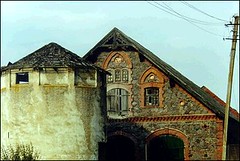We have received an arts residency in Mooste, Estonia at the MoKs Center for Art and Social Practice for June 2009.
Intrigued by the work of glamour photographer Harry Egipt, who created dynamic and puzzling TV commercials for food items during the 1980s that glamorized and often eroticized Estonians’ most basic forms of sustenance, we proposed an interdisciplinary project, The Sex God of (Soviet) Estonia to explore contemporary Estonian food culture through a series of experimental meals. Over the course of our month long residency at MoKs, which itself used to be a farming estate, we would like to directly involve local community members – farmers, cooks, homemakers, shopkeepers, gastronomes, artists, musicians and enthusiasts - in a celebration of local food in Mooste. We will study Estonian ecology and agriculture, receive lessons in Estonian cooking and explore ways of collectively performing and exploring our sensual appetites to excite and enjoy the wonderful ritual of eating together.
During our stay, we will hold three special meals, one during a morning, one mid-day and one at night, each in a different location either indoors or outdoors, that will be planned, created and hosted by us with assistance from community members. Each meal will individually offer immersion in specific aspects of local gastronomic customs and ingredients, and the series will collectively offer our sense of the Estonian culinary tradition.
To compliment the cuisine, the meals may be flavored by the following multimedia ingredients:
1) Interactive, amplified or performed sound. Music that relates to the aesthetic, political or commercial histories of the foods being consumed; sounds that emphasize the sensory experiences of the particular ingredients; noises that playfully call attention to the act of eating and interacting; sound documents from the region; ambient palate stimuli.
2) Set dressings. Specific lighting, table settings, furniture and visual decoration to convey each meal’s specific sensibility and to utilize elements of the Estonian aesthetic as inspired by local flora and fauna, pop culture and folk tales.
3) Costume. Participants may be asked to wear particular types of dress or given garments made or collected for the occasion.
4) Entertainment. Projected video, live performance, musical accompaniment, a related talk or lecture, group activity.
We will use this blog over the next 9 months to post our ideas, research, experiments, documentations and reflections about the process and performance of this project. Before we ourselves began this adventure, we knew little to nothing about Estonia, and most of our friends and family were just as clueless as us, one forgetting even its name, referring to our project's location as being "that foreign place." We hope, therefore, our experience can be as illuminating for you as for us!
Check out MoKs here: http://moks.ee/
Subscribe to:
Post Comments (Atom)








No comments:
Post a Comment